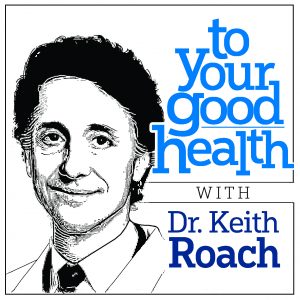TO YOUR GOOD HEALTH: Heart attack vs. stroke: Balancing the risks
By Dr. Keith Roach — April 12, 2021DEAR DR. ROACH: Your recent article on statins/strokes piqued my interest since you mentioned that statins might cause hemorrhagic strokes. My husband had a hemorrhagic stroke in 2014, cause unknown. The stroke caused aphasia and seizures. He was prescribed Crestor 10mg and then increased it to 20mg. His calcium score is very high.
He also had an ischemic stroke in February 2019 and was prescribed aspirin and 40 mg of atorvastatin. I am more concerned now as to whether he should be taking statins. His LDL is 63 and HDL is 47. Your comments on this would be appreciated. — F.D.
ANSWER: Before I comment on your husband’s situation, let me make a few of the terms clear. An intracranial hemorrhage is a bleed inside the brain. The resultant pressure inside the head can cause permanent damage to nearby brain structures: a hemorrhagic stroke. Risk factors for a hemorrhagic stroke include anticoagulants — aspirin has a very small risk, but other agents, especially warfarin (Coumadin) and to a lesser extent, newer agents such as dabigatran (Pradaxa), have a more significant risk.
Poorly controlled high blood pressure is a risk, as is consumption of large amounts of alcohol. Some people have no identifiable risk.
Your husband’s case is a situation that requires clinical judgment and more knowledge than I possess to give the most informed answer. However, for most people, the risk of an ischemic stroke and of a heart attack is significantly higher than the risk of hemorrhagic stroke. Further, the benefit in statins helping with heart attack and ischemic stroke is well-studied and moderate in magnitude.
By contrast, the increase in hemorrhagic stroke risk, if any, is likely to be small. The balance of risks would be in favor of treating. His high calcium score indicates a higher risk for heart attack, making a statin more important for him. If he had a risk factor for his previous hemorrhagic stroke that can be modified, then I would be more confident of the net benefit of a statin.
***
DEAR DR. ROACH: What is the safest and most effective way to clean wax from ears? I have worn hearing aids for roughly 40 years, but with a new set of high-tech hearing aids, ear wax has become a problem. How can I best remove it without using a sharp tool to dig it out? — M.L.W.
ANSWER: Most people do NOT need to do anything about ear wax, and many traditional home remedies are unsafe. The old advice to never put anything smaller than your elbow in your ear is a good one for most people. Candling is unsafe and ineffective. Anything sharp is very dangerous.
For someone with recurrent ear wax, especially with a hearing aid, one approach is to use a cotton ball dipped in mineral oil and place in the external ear canal for 10-20 minutes once a week. This can be followed by a gentle rinse with warm water using a rubber bulb syringe. The cotton ball treatment can be used to prevent symptoms as well as to treat mild cases.
Another option is the use of an ear wax removing agent, such as carbamide peroxide. These can be irritating and should not be used routinely — only for symptoms.
If you don’t get relief after a few days of home treatment, you’ll need to have your clinician look into your ears.
Dr. Roach regrets that he is unable to answer individual questions, but will incorporate them in the column whenever possible. Readers may email questions to ToYourGoodHealth@med.cornell.edu.
© 2021 North America Synd., Inc.
All Rights Reserved








